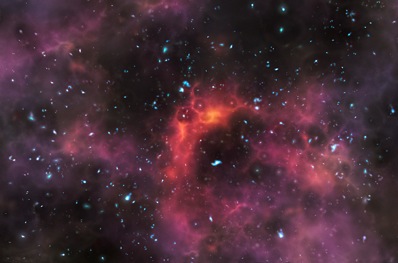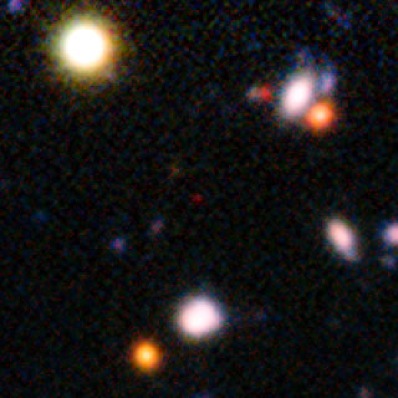



|

|

Clearing the cosmic fog from the early Universe
DR EMILY BALDWIN
ASTRONOMY NOW
Posted: 12 October 2011


Using the European Southern Observatory's Very Large Telescope (VLT) to study the Universe's early galaxies, astronomers have established when the Universe became transparent to ultraviolet light, a period of time known as the reionization epoch.
During the reionization phase, which occurred around 13 billion years ago, the fog of hydrogen gas that permeated the new born Universe began to clear, allowing ultraviolet light to travel freely for the first time.

This artist’s impression shows galaxies at a time less than a billion years after the Big Bang, when the Universe was still partially filled with hydrogen fog that absorbed ultraviolet light. Image: ESO/M. Kornmesser.
Using 200 hours of VLT time to identify targets, and an additional 60 hours to take spectra, a team of astronomers probed extremely faint galaxies to measure their Lyman-alpha emission lines, a bright signature that originates from hydrogen gas within the galaxies. This fingerprint was detected in five of the 20 candidate galaxies that the team observed at around redshift 7, a distance measurement corresponding to an age of just 780 million years after the big bang.
Determining the exact distances of each of the five galaxies allowed the team to place the galaxies in order, showing how their Lyman alpha emission – and hence the progress of the reionization epoch – evolved over time. They discovered a dramatic difference in the amount of ultraviolet light that was blocked between the earliest and latest galaxies in the sample.
“When the Universe was only 780 million years old this neutral hydrogen was quite abundant, filling from 10 to 50 percent of the Universe’ volume," says lead author Laura Pentericci of INAF Rome Astronomical Observatory. "But only 200 million years later the amount of neutral hydrogen had dropped to a very low level, similar to what we see today."

The red speck at the centre of this very deep image from the ESO Very Large Telescope shows the galaxy NTTDF-474, seen when the Universe was only 820 million years old. It is one of the most distant ever to have had its distance measured accurately, and is one of five that have been used to chart the timeline of the reionisation of the Universe about 13 billion years ago. Image: ESO/ L. Pentericci.
Co-author Adriano Fontana adds that although reionization must have happened quicker than previously thought, this is actually expected in some theoretical models. "They predict that primeval galaxies ionized the Universe starting from their surroundings, creating "bubbles" of ionized space around them. These bubbles enlarge with time and when they overlap the ionization is complete, and this may produce a sharp increase in the transmission of UV light," he says. "Nevertheless, the speed of the transition is surprising – we clearly need to accumulate larger samples to measure this effect even more accurately, and to re-think some of the theory to explain it."
The observations may also shed some light on what produced the ultraviolet radiation that first triggered reionization, hinting at the Universe's first generation massive stars, rather than the other contender of energy emitted by black holes, as the likely culprits.
"We know that, for stars to be the main contributors, they must be very massive, probably with very low metallicities, and the galaxies they reside in must have very little or no internal dust and gas, to avoid absorbing their light," explains Fontana. "These features produce a typical spectrum and some of our sources, and in particular those with the highest quality and distance, seem to show this spectral feature, since their spectrum is extremely "blue", as expected if there is no dust and the stars are metal poor."
Confirming or refuting this piece of the cosmic puzzle will likely fall to the eyes of the proposed 39.3 metre wide mirror of the European Extremely Large Telescope (E-ELT). "There are fainter spectroscopic signatures that can be observed in our objects," adds Fontana. "Their detection would be the "smoking gun" of first generation of stars. In particular, the detection of a faint emission from primordial helium in these objects would be decisive. We will try to push VLT to its very limit to observe this element, but we will probably need E-ELT for this. Stay tuned!"
|

|

|

|
|



